Beets - one of the most healthy and vitamin vegetables in the garden. It is fully edible, not only root vegetables, but also leaves can be eaten. There are no restrictions on the method of preparation - beets are suitable for food not only after heat treatment, but also in raw form.
Another plus is unpretentiousness in leaving. But, nevertheless, it is recommended to follow certain rules when growing, including observing the time when to plant beets in 2019 according to the lunar calendar.
Content
Landing dates - lunar calendar recommendations
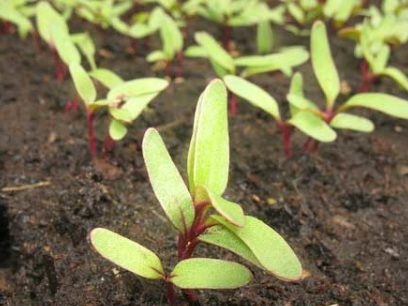 To get a good beet crop, the grower needs to choose the right time for planting. The lunar calendar of the gardener, which scientists make together with astrologers, helps to determine the favorable period for planting the root crop. This reference material contains a list of suitable and unfavorable days for various fruit and ornamental crops.
To get a good beet crop, the grower needs to choose the right time for planting. The lunar calendar of the gardener, which scientists make together with astrologers, helps to determine the favorable period for planting the root crop. This reference material contains a list of suitable and unfavorable days for various fruit and ornamental crops.
To plant beets on seedlings and sow in open ground they are not recommended during the full moon and on the new moon, since the vegetable crop in this period does not take root well, develops slowly and yield decreases as a result. When planting vegetation, the vegetable grower first of all takes into account what the crop belongs to - tops or roots. So, beets are a “spine”, then this vegetable is usually planted on the waning moon. Therefore, favorable days for growing beets are the following dates:
- March - 2nd, 5th, 22nd, 24th, 26th, 27th and 29th;
- April - 3, 20, 21, 24, 25, and 30;
- May - 1, 21, 23, 27 and 28 numbers;
- June - 1st, 18th, 24th and 29th.
If the grower determines when to plant beets for seedlings, then it must be taken into account that the root crop must be planted in open ground after 1 month. Because of this, it is necessary to take into account not only the recommendations of the lunar calendar, but also the climatic conditions of a certain region and the weather forecast, since spring can be early or late. In addition to favorable days, there are also unsuitable dates when planting beets for seedlings in 2019 is not recommended:
- in March - 6 and 21 numbers;
- in April - 5th and 19th;
- in May - 5th and 19th;
- in June - 3 and 17 numbers.
 You may be interested in:
You may be interested in:All other dates, except for favorable and not suitable for planting beet days, are classified as neutral. These numbers recommend that vegetable growers pay attention to the general position of the celestial body and focus on current weather conditions. If you pay attention to the set of recommendations of astrologers, the typical climatic features of the region and the weather outside, it is possible to grow a rich beet crop without unnecessary effort and time.
When to sow beets in open ground
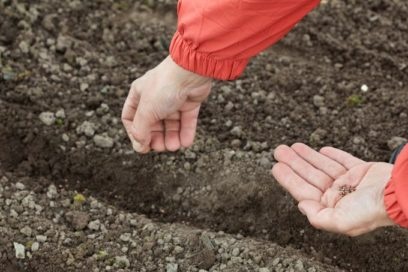 Beets are considered a relatively heat-loving crop, so sow it in the spring in open ground It is recommended that when the soil warms up sufficiently, that is, the temperature of the earth will reach 10 ̊ С. Taking into account climatic features, in the Urals and in the Siberian Territory, sowing of crops directly to the site is carried out in the second part of May. But, in the southern regions, the suitable time is the end of March, the first of April. In the Moscow region and the middle zone, it is advised to sow root crops not earlier than the last days of April and early May. In the Leningrad Region, beets must be sown in open ground 1 week later than in the case of Moscow and Moscow oblast.
Beets are considered a relatively heat-loving crop, so sow it in the spring in open ground It is recommended that when the soil warms up sufficiently, that is, the temperature of the earth will reach 10 ̊ С. Taking into account climatic features, in the Urals and in the Siberian Territory, sowing of crops directly to the site is carried out in the second part of May. But, in the southern regions, the suitable time is the end of March, the first of April. In the Moscow region and the middle zone, it is advised to sow root crops not earlier than the last days of April and early May. In the Leningrad Region, beets must be sown in open ground 1 week later than in the case of Moscow and Moscow oblast.
A certain time for sowing needs to be selected not only taking into account weather conditions and the favorable period according to the lunar calendar, but it is also necessary to take into account the variety and recommendations of the seed producer. So, in the case of early ripening varieties, it is necessary to prepare beds earlier than for late ripening. This is due to the fact that if the sowing of late varieties is excessively early, the result is a root crop whose pulp is too hard.
To get a rich harvest of root vegetables, the vegetable grower must observe not only the timing of the start of planting events, but also select the correct planting scheme. In the case of elongated and narrow beds, the root crops are sown across, and a distance of 10 cm is maintained between the seeds. Moreover, between the twin beds it is necessary that there is a distance of 25 cm. This facilitates care in the case of irregularly shaped gardens. The scheme of such a landing is called single-line.
When the site allows, then use a two-line or three-line scheme. The distance between the paired rows is 25 cm. At the same time, there should be an indent of 50 cm on both sides of the twin beds - this is the correct option for alternating plantings. You can also apply a three-line scheme, when the beds are triple (the distance between the rows is the same as in a two-line landing). A similar order is made to facilitate the care of growing beets - so that it is easier to carry out weeding, cultivation and watering.
Seedling method of growing
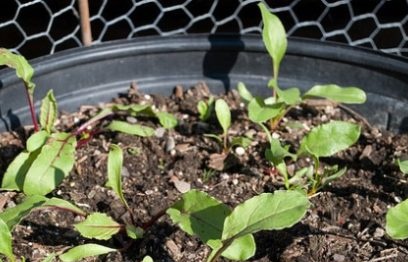 Vegetables are grown for seedlings in many ways - each of them has certain advantages. Sowing beets for seedlings is also possible in many ways, but there are three of the most convenient and effective. Growing vegetable seedlings using a warm ridge, seedling cups and in a snail. These techniques are simple and beetroot is a picky plant, which only simplifies the process of preparing seedlings.
Vegetables are grown for seedlings in many ways - each of them has certain advantages. Sowing beets for seedlings is also possible in many ways, but there are three of the most convenient and effective. Growing vegetable seedlings using a warm ridge, seedling cups and in a snail. These techniques are simple and beetroot is a picky plant, which only simplifies the process of preparing seedlings.
When preparation for deepening beet seeds into the ground to obtain seedlings is not complete or mistakes were made, young plants may begin to hurt. To prevent this, the grower needs to correctly select seeds for germination, prepare a suitable soil mixture and seedlings, and also select a place where young plants will develop and expect a transplant. If at least one of the preparatory steps has been ignored, the following problems may occur during seedling growth:
- Lack of moisture or lighting leads to seedlings developing poorly.
- When the leaves begin to turn red at the seedlings, they need top dressing with purchased fertilizer containing sodium or wood ash.
- If the tops are drying, then the plant is deficient in manganese.
- When softening the "hearts" you need spraying with fertilizer with boron.
Vegetable culture is highly susceptible to various diseases of a fungal nature. These diseases develop when the soil is waterlogged in seedlings, with a lack of boron, or when acidic soil is used as a substrate.To prevent damage to beet seedlings by peronosporosis, fomosis, cercosporosis and fusarium rot, it is necessary not to overfill the substrate. When the first signs of illness appeared, young plants should be treated with Bordeaux liquid, and the damaged parts should be removed.
Preparing for growing seedlings
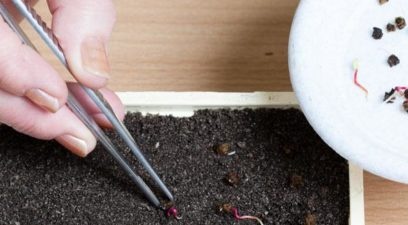 First of all, the vegetable grower needs to make sure the quality of the seed material. For this, calibration is performed - seeds are selected by size. It is possible to literally “weed out” too small and empty seeds through a sieve. When the seed is too small, you can use another method - using an electrified stick to sort the empty shells from those seeds that will germinate. After the selection of material suitable for sowing is completed, disinfection is necessary, which can be performed using the Epin preparation, a cherry solution of magnesium permanganate, or aloe juice.
First of all, the vegetable grower needs to make sure the quality of the seed material. For this, calibration is performed - seeds are selected by size. It is possible to literally “weed out” too small and empty seeds through a sieve. When the seed is too small, you can use another method - using an electrified stick to sort the empty shells from those seeds that will germinate. After the selection of material suitable for sowing is completed, disinfection is necessary, which can be performed using the Epin preparation, a cherry solution of magnesium permanganate, or aloe juice.
After calibration and disinfection, good seeds are soaked and left to swell. Dry beet seeds are placed on moistened gauze (cotton pad) and cover from above. Soak with settled or melt warm water. But, you can use special solutions of Nitrofoska, Humate Potassium, Zircon or Novosil preparations. There are folk recipes of natural growth stimulants, which involve the preparation of a solution based on 1 liter of water and 1 tsp. soda or wood ash in the same proportion. A container with swelling seeds is left warm for 2 days. After the emergence of sprouts, the seeds are buried in the prepared soil mixture.
To prevent the death of beets due to a sudden cooling after planting in open ground, it is necessary to perform vernalization. Hardening is an optional manipulation, but it is desirable to carry it out. To increase resistance to cold, you need to send them to the lower shelf of the refrigerator after swelling the seeds in water or a solution of a growth stimulant, where they will lie at a temperature of -1 to +1 ̊С for 7-10 days. But vernalization is possible only before the germ.
Methods for producing beet seedlings
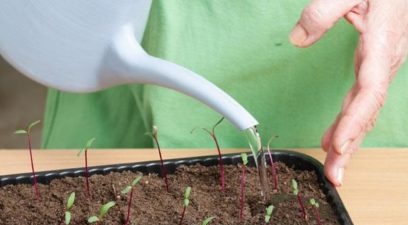 A relatively new way to obtain seedlings is when beets are planted in a snail. This design for germinating seed material consists of spiral-rolled paper or other dense material with or without earth, where toilet paper plays the role of soil. Seeds are placed on a strip with an interval of 10 cm and twisted. After, when the seedlings have grown enough, the snail is deployed and the young plant is carefully taken out. When using the cochlea after thinning, the root system of each specimen is virtually intact.
A relatively new way to obtain seedlings is when beets are planted in a snail. This design for germinating seed material consists of spiral-rolled paper or other dense material with or without earth, where toilet paper plays the role of soil. Seeds are placed on a strip with an interval of 10 cm and twisted. After, when the seedlings have grown enough, the snail is deployed and the young plant is carefully taken out. When using the cochlea after thinning, the root system of each specimen is virtually intact.
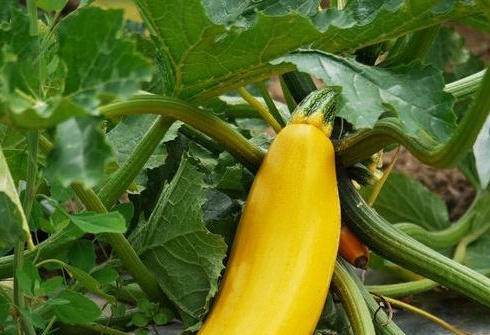 You may be interested in:
You may be interested in:Growing beet seedlings using the warm ridge method involves digging a pit 30-40 cm deep and up to 50 cm wide, in which straw, manure and rotted plant remains are placed. Germinated seeds are buried in the nutrient mixture by 1.5-4 cm. A distance of 8 cm is maintained between the wells. On top of the organics, make a mound of earth that rises 30-40 cm above the ground. The mound is needed to protect young plants from coming from the soil cold. At first, they recommend digging a warm ridge with polyethylene. After air reaches a temperature of + 18 ... + 20 ̊С, beets can be transplanted to a permanent place.
Sowing beets in seedlings is a standard method of obtaining seedlings. The main thing is that there is good drainage, which will prevent stagnation of water in the ground.2-3 seeds are buried in each glass. First, use a container with a capacity of 200 ml, and then, after the plants have grown, they are transplanted into glasses with a volume of 500 ml. When using this technique, you need to carefully dive seedlings, as there are high risks of damage to the root system.
Planting beet seedlings in open ground
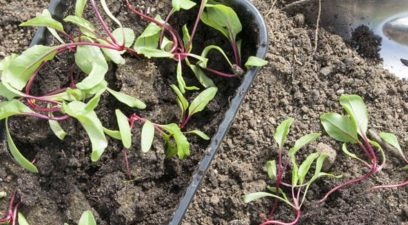 Before planting beet seedlings on the site, you need to prepare the soil. This procedure is carried out in the autumn period, starting with the marking of the site for planting vegetation for the next season. For beets, a well-lit area is chosen, only in this way can you get saturated color fruits. Fertile loamy or loamy soil with neutral acidity is suitable for this vegetable. In order for the beets to develop normally and give a good harvest, you also need to perform the following series of procedures:
Before planting beet seedlings on the site, you need to prepare the soil. This procedure is carried out in the autumn period, starting with the marking of the site for planting vegetation for the next season. For beets, a well-lit area is chosen, only in this way can you get saturated color fruits. Fertile loamy or loamy soil with neutral acidity is suitable for this vegetable. In order for the beets to develop normally and give a good harvest, you also need to perform the following series of procedures:
- Eliminate plant debris from last season. To do this, carefully clean the soil from root inclusions with the help of a pitchfork.
- To apply organic fertilizers - 3 kg of humus or compost for each square meter.
- Supplement fertilizer with mineral compounds based on ammonia, potassium and phosphate compounds.
- To reduce the acidity of the soil, add dolomite flour, wood ash or lime from 0.5 kg per 1 m2.
- Dig the soil in the area with a cultivation depth of up to 30 cm (the length of the working part of the bayonet shovel).
Transplant seedlings into the ground begin with the layout of the rows on the site. Wells are prepared on each of them, in volume corresponding to an earthen coma on plants. The gaps between individual plants are about 5-7 cm, so the bushes will not interfere with neighboring ones. When young plants are planted in the holes, the free space is filled with earth from the plot or seedling substrate. At the end of the procedure for planting beets in open ground, the garden is watered with warm water.
Site Care Technique
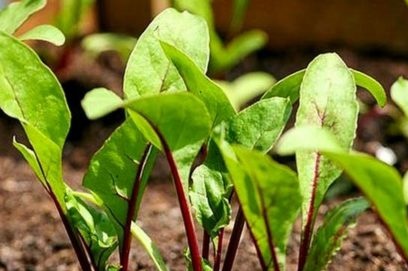 If the planting procedure was carried out in compliance with all norms, then after 5-7 days, the full adaptation of young plants to the conditions of maintenance is noted. However, further care is also necessary to get a good harvest. To maintain the proper development of the root crop, you need to constantly loosen the soil. It is especially important to perform this procedure in rainy periods - the moisture will come off faster, and the root will be provided with the right amount of air. Thinning beets is a necessary procedure throughout the development of the plant. This procedure is performed in accordance with such standards:
If the planting procedure was carried out in compliance with all norms, then after 5-7 days, the full adaptation of young plants to the conditions of maintenance is noted. However, further care is also necessary to get a good harvest. To maintain the proper development of the root crop, you need to constantly loosen the soil. It is especially important to perform this procedure in rainy periods - the moisture will come off faster, and the root will be provided with the right amount of air. Thinning beets is a necessary procedure throughout the development of the plant. This procedure is performed in accordance with such standards:
- The primary thinning of the beds with beets is performed when the plants reach a height of 6-8 cm. The weakest plants are removed and the distance between the remaining plants is expanded to 5 cm.
- Weeds need to be eliminated constantly - when weeds appear among the beets, it may lack nutrients.
- The second thinning of the vegetable should be carried out when the root head appears on the surface. The distance is increased to 10-20 cm between the fruits.
Abundant watering of plants transplanted to the site begins after the initial thinning. Further provision of the vegetable with water is carried out once a week. 1-1.5 buckets (per 8 or 10 liters) are spent on 1 m2. To adjust the amount, the condition of root crops is monitored - when there is a lack of moisture, they become dry and shallow. Stop watering 2-3 weeks before harvest.
Fertilizer use
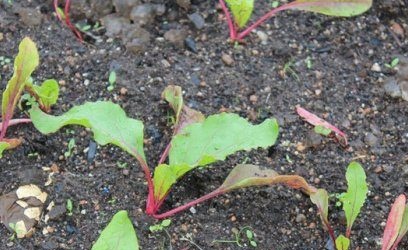 The use of top dressing when growing beets on the site is not necessary if preliminary soil fertilization has been carried out since autumn. When the soil has not been updated before planting, such a measure will help provide the root crop with the right amount of nutrient components. The first feeding of vegetation is carried out one day after the primary thinning of the beds. The following compounds are suitable as fertilizer:
The use of top dressing when growing beets on the site is not necessary if preliminary soil fertilization has been carried out since autumn. When the soil has not been updated before planting, such a measure will help provide the root crop with the right amount of nutrient components. The first feeding of vegetation is carried out one day after the primary thinning of the beds. The following compounds are suitable as fertilizer:
- Herbal infusion made from nettle and dandelion.For this, the collected herbs are boiled in 10 liters of water and insisted for a week.
- Sodium nitrate, which is bred according to the instructions on the package. The solution is poured under the plants as watering.
- Saline solution is prepared in proportions - 20 g of salt per 12 liters of settled irrigation water.
- Solutions based on boron - the tool "Mag-Bor" or boric acid in an amount of 0.5 tsp. for 10 liters of water.
Favorable harvesting time
When the sowing dates and care standards are met, the quantity and quality of harvested root crops is decent, but you also need to collect beets at the right time. If you harvest in a timely manner, then the quality of the product and its shelf life will be higher. If the moon is in the sign of a virgin or fish, it is not recommended to collect root vegetables, since the root crop will be watery. As directed by experienced astrologers, favorable days for harvesting beets when considering lunar activity are as follows:
- July - 23-27;
- August - 19-25;
- September - 8-9.16-21.25-26;
- October - 3-6, 15-29, 22-25.
A month is determined by the regional climate, for example, in the Moscow region it is better to harvest no later than September. If the moon phase in Gemini during the beet harvesting period, then the root crop is stored for more time. Nevertheless, when choosing a favorable period for beets according to the lunar calendar, weather conditions should be taken into account - if it rains on the date and it is not possible to harvest the drizzle. Beets will gain a lot of moisture and increase in size, but will be watery and cracked. After the rainy period, you need to wait 2-3 days of dry weather and only after harvesting.

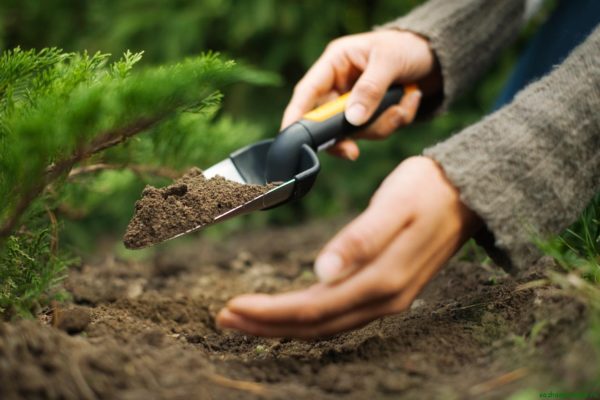 Sowing calendar for August 2024
Sowing calendar for August 2024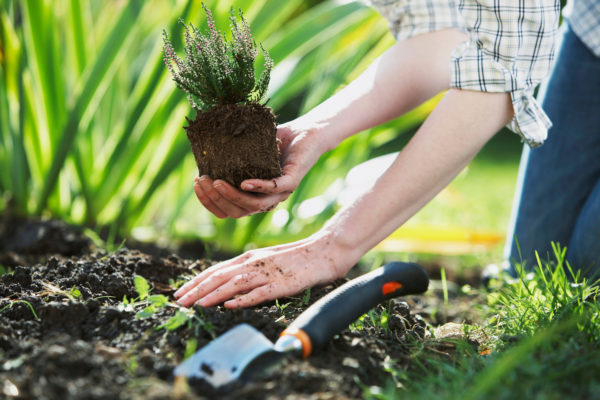 Sowing calendar for June 2024
Sowing calendar for June 2024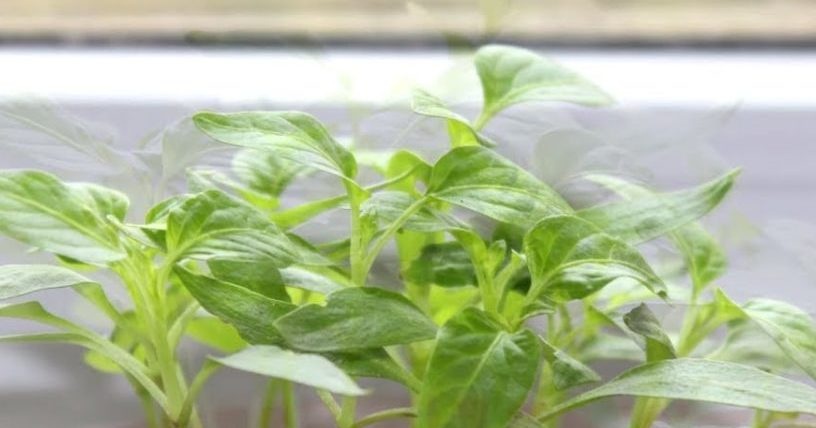 Sweet pepper (Bulgarian) - planting dates for seedlings and the lunar calendar 2024
Sweet pepper (Bulgarian) - planting dates for seedlings and the lunar calendar 2024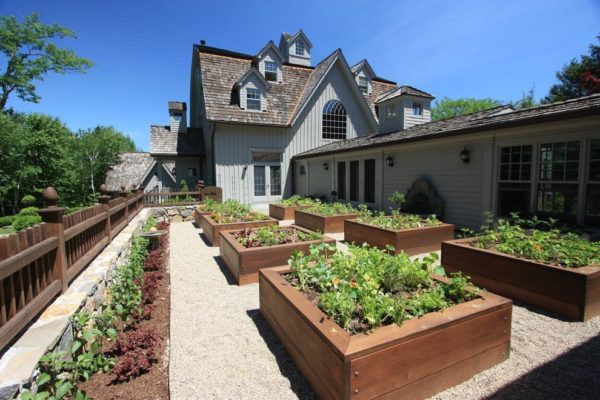 Boarding days in June 2019: favorable days
Boarding days in June 2019: favorable days